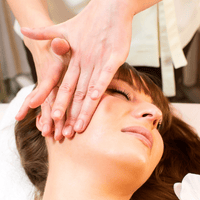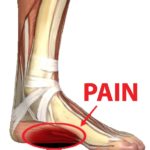
6 minute read
Is Your Foot Running Well?
We have seen increasing numbers of people hurting themselves with foot pain whilst trying home exercises especially running. This can cause many problems in the body, not just the foot. The underlying link to this problem is the choice of daily footwear, and not necessarily the running shoes alone!
Author's Note: whilst this article was written for runners, if it can help runners with the harsh forces they have to cope with on their feet, please feel assured it can help you too for a “normal” foot problem.
People may buy the best running shoes they can afford, then at other times of the week, they use other footwear that slowly under the radar can weaken the foot. This can result in heel pain, Achilles pain, planter fasciitis, foot pain, pain into the lower leg, knee pain, aching feet and more.
So we need to look at two things. Here I am particularly thinking of sandals, flip flops, slip-on shoes, Velcro’s fastener, zip-up shoes, boots without any fastenings (ie Ugg style), slippers and… bare feet. Next is the issue of wearing footwear correctly. Unless worn properly it contributes to a whole host of problems. As an osteopath of over 30 years, I see this so often.
But first to understand what is going on we need to look at the anatomy of the foot itself.
Arches of the Foot
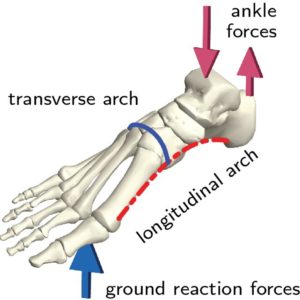
Contrary to popular belief, there is not one, but two arches in the foot. If either arch is compromised, difficulties can arise. The first arch is the one we all know about, the instep arch, also known as the arch of the foot. The second arch is across the foot (transverse arch), running side to side across the foot. It forms the mid part of the foot. This should be rather like a humped back bridge when looked at end on from the toes.
What Weak Feet look like
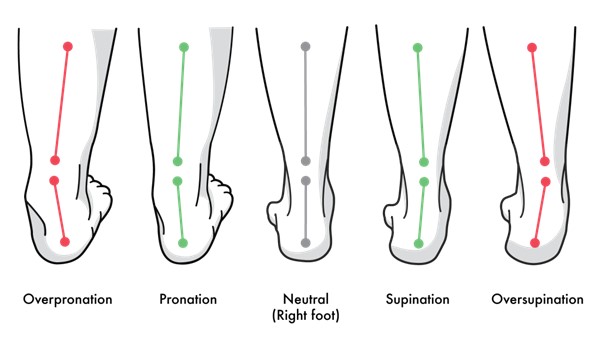
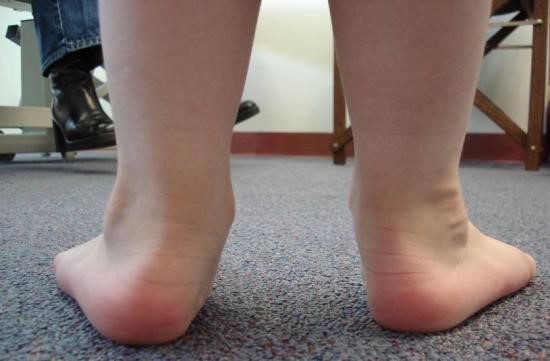
As you might imagine when looking at the picture above, the muscles of the lower leg must work harder to keep the ankle supported. But the muscles were never intended to do this, they are designed for us to walk, stand, jump, run, move! In other words they cant do both and it’s a bit like the body is saying “pick one – I cant do both”. So naturally if you force it to do both, something eventually may go wrong. The exact location of the pain can be anywhere from the foot, Achilles tendon all the way up the body, depending on the person’s centre of gravity, their natural anatomy and how they are using their body.
One of the first patients’ I treated as an undergraduate in 1984 was a cocktail waitress who had neck pain. To cut a long story short, it turned out to be because of her feet.
Running on weak ankles
Now let’s consider what happens if we run on the compromised foot. To be more precise, when we run it is the only time a human being is literally flying, viz, both feet are off the ground at the same time. So when we land the entire person's weight has to be absorbed on impact, (ie 78kg for a man). The first landing point is of course the foot, but at what cost? Over time the overworked muscles are now asked to do three things, stabilise the foot, locomotion and finally absorb the landing force. The cost of this weakens the foot (pronates it) and the soft-tissues can undergo injury, ie pulled muscle, Achilles tendonitis or planter fasciitis etc.
See the right-image below and how the foot is “rolling out” pronating.
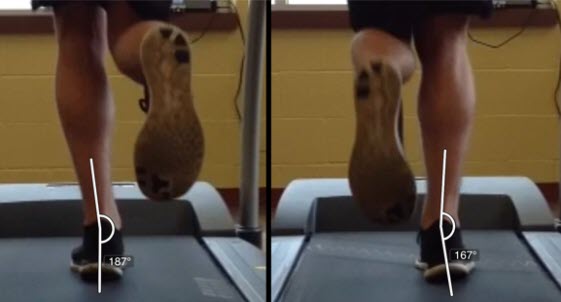
Self Assessment
So what can be done. First, lets check that the foot is actually pronated. If not it may be another problem. So get someone to stand behind you and have a look. If you are unsure, you are welcome to send me a picture and I can have a look for you (see end of article)*.
If pronation exists you may need to take extra care. Such care is measured in many months. You may need to wear insoles (orthotics) for this period. These help the foot to stay supported – and in so doing it gives a rest to the overworked, aching tissues. It gives them a rest, and it gives the ligaments time to re-tighten naturally. The re-tightened ligaments hold the bones of the foot together – so the muscles of the lower leg and the foot no longer have to double up to do this job. The muscles can get back to doing what they do best, walking, running, moving etc. In addition to orthotic insoles this would be combined with remedial exercises which we prescribe together as part of our in-house foot treatment osteopathy.
Orthotics (Insoles for feet)
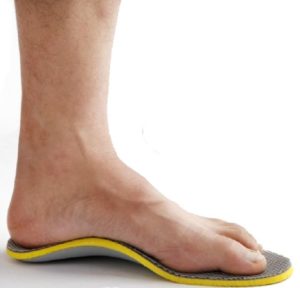
For some using orthotics may mean removing the insole that came with the shoe and replacing it with the new one, and for some, it may mean buying a larger shoe. So I recommend always take your orthotics with you when buying new shoes. On the point of shoes, I highly recommend not to wear anything except lace-ups.
That all said, it’s no use doing all this “good” on the one hand, and then doing “bad” in between. This means (a) you need to wear the orthotics continually, ie avoid wearing sandals, flip-flops, or going bare-feet – a real problem in summer!; And (b) think about using lace up shoes with your orthotics to help maintain the transverse arch. So things like wellies, Velcro fasteners, zip-ups, Ugg style boots etc don’t help. Also remember if you are able to get your foot back into the lace-up shoe without undoing the laces it’s not supporting the foot adequately.
The Big Ask
For some people this is all a big ask. I know people have their favourite footwear and they don’t feel they are compromised by it. To these people I say it’s a bit like smoking. Whilst you're doing it you don't notice much change, but with time, damage takes place. Perhaps it’s a mental change as much as a physical change that is required to make this (medium term) improvement.
For some using orthotics may mean removing the insole that came with the shoe and replacing with the new one, and for some, it may mean buying a larger shoe. So I recommend always take your orthotics with you when buying new shoes. On the point of shoes, I highly recommend not to wear anything except lace-ups.
Osteopathy for real change
Osteopathy is not just about fixing a problem, it’s about helping you to achieve the changes you need for your body to thrive. Osteopathy works at physical and intellectual levels. Your Osteopath is here to help you take the steps you need to take, to create the outcome you are seeking. If all you want is a quick fix – fine. But if you want more we can help you get better and stay better. After all, I say to my patients getting better is the easy bit, staying better is a lot harder.
Of course there are short-cuts your Osteopath can offer you on your healing journey. But at the end of the day only the patient knows the life demands upon them. And it is the patient who has to balance the healing needs with lifestyle demands.

Vispi Jamooi DO PG Cert SPOP
Osteopath
Email: vispi@lccosteo.com











